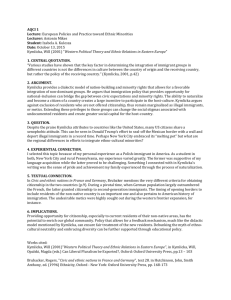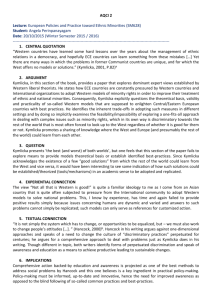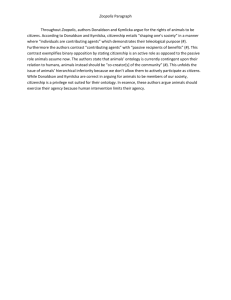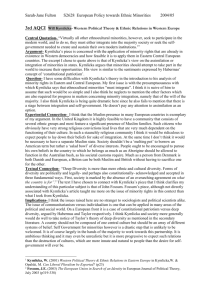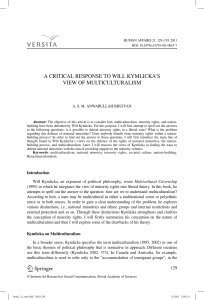AQCI #3 Mikhail Karpenko 19.11.2015
advertisement
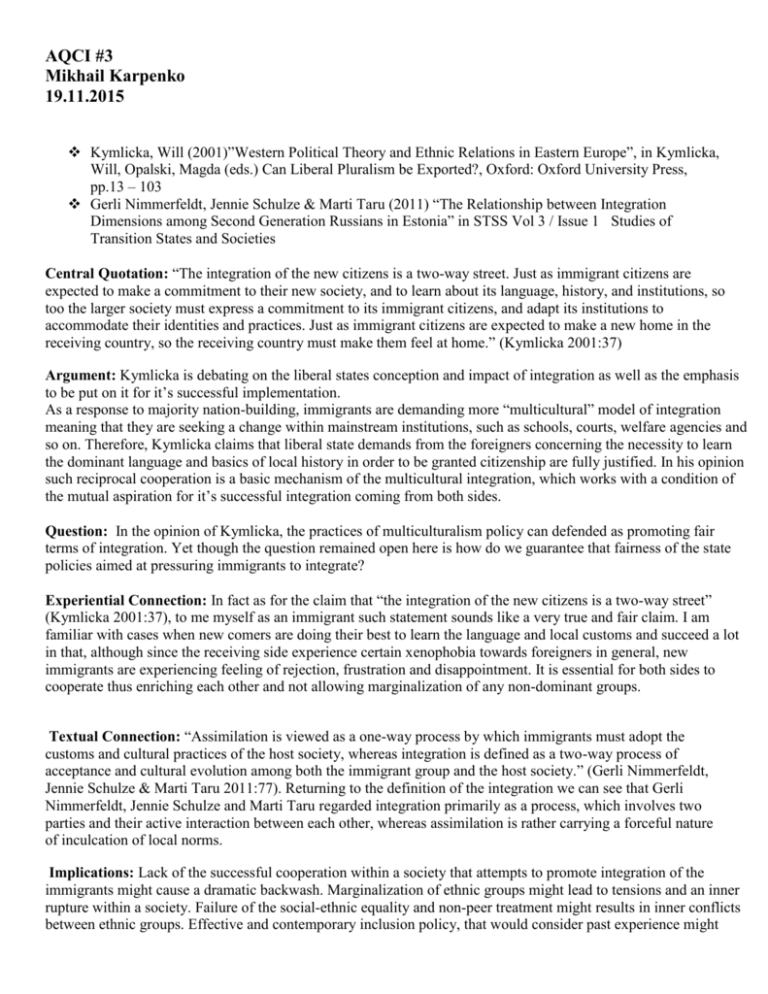
AQCI #3 Mikhail Karpenko 19.11.2015 Kymlicka, Will (2001)”Western Political Theory and Ethnic Relations in Eastern Europe”, in Kymlicka, Will, Opalski, Magda (eds.) Can Liberal Pluralism be Exported?, Oxford: Oxford University Press, pp.13 – 103 Gerli Nimmerfeldt, Jennie Schulze & Marti Taru (2011) “The Relationship between Integration Dimensions among Second Generation Russians in Estonia” in STSS Vol 3 / Issue 1 Studies of Transition States and Societies Central Quotation: “The integration of the new citizens is a two-way street. Just as immigrant citizens are expected to make a commitment to their new society, and to learn about its language, history, and institutions, so too the larger society must express a commitment to its immigrant citizens, and adapt its institutions to accommodate their identities and practices. Just as immigrant citizens are expected to make a new home in the receiving country, so the receiving country must make them feel at home.” (Kymlicka 2001:37) Argument: Kymlicka is debating on the liberal states conception and impact of integration as well as the emphasis to be put on it for it’s successful implementation. As a response to majority nation-building, immigrants are demanding more “multicultural” model of integration meaning that they are seeking a change within mainstream institutions, such as schools, courts, welfare agencies and so on. Therefore, Kymlicka claims that liberal state demands from the foreigners concerning the necessity to learn the dominant language and basics of local history in order to be granted citizenship are fully justified. In his opinion such reciprocal cooperation is a basic mechanism of the multicultural integration, which works with a condition of the mutual aspiration for it’s successful integration coming from both sides. Question: In the opinion of Kymlicka, the practices of multiculturalism policy can defended as promoting fair terms of integration. Yet though the question remained open here is how do we guarantee that fairness of the state policies aimed at pressuring immigrants to integrate? Experiential Connection: In fact as for the claim that “the integration of the new citizens is a two-way street” (Kymlicka 2001:37), to me myself as an immigrant such statement sounds like a very true and fair claim. I am familiar with cases when new comers are doing their best to learn the language and local customs and succeed a lot in that, although since the receiving side experience certain xenophobia towards foreigners in general, new immigrants are experiencing feeling of rejection, frustration and disappointment. It is essential for both sides to cooperate thus enriching each other and not allowing marginalization of any non-dominant groups. Textual Connection: “Assimilation is viewed as a one-way process by which immigrants must adopt the customs and cultural practices of the host society, whereas integration is defined as a two-way process of acceptance and cultural evolution among both the immigrant group and the host society.” (Gerli Nimmerfeldt, Jennie Schulze & Marti Taru 2011:77). Returning to the definition of the integration we can see that Gerli Nimmerfeldt, Jennie Schulze and Marti Taru regarded integration primarily as a process, which involves two parties and their active interaction between each other, whereas assimilation is rather carrying a forceful nature of inculcation of local norms. Implications: Lack of the successful cooperation within a society that attempts to promote integration of the immigrants might cause a dramatic backwash. Marginalization of ethnic groups might lead to tensions and an inner rupture within a society. Failure of the social-ethnic equality and non-peer treatment might results in inner conflicts between ethnic groups. Effective and contemporary inclusion policy, that would consider past experience might help to bring people together, prevent the social division and ensure treatment that correspond to the basics of human dignity and principles of democracy. AQCI ASSESSMENT FORM Student’s name: Name of assessor: Date: Essay title: Excel lent 1) Is the chosen quotation central to the author’s argument? 2) Has the main argument been fully understood (including its ‘for’ and ‘against’ sides, if applicable)? 3a) Is the question raised important/relevant/interesting? 3b) Has this question not been fully answered in the text? 4) Is the experiential connection relevant/interesting? 5a) Is the textual connection relevant/interesting? 5b) Has it been cited properly? 5c) Has it been adequately explained how the present text's argument contrasts with, contradicts, confirms, clarifies, or elaborates the other text's argument or point? 6) Have the implications been well understood, can they have a practical impact for policy making? 7) Expression/Presentation a) Are the style, grammar and general use of English adequate? b) Is the AQCI professionally presented? Essay grade: Further comments: Go od Aver age Po or Not accept able Comments
